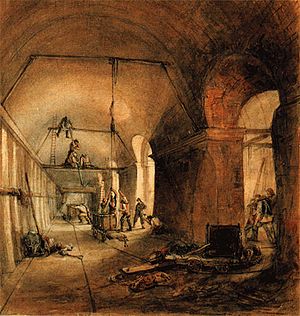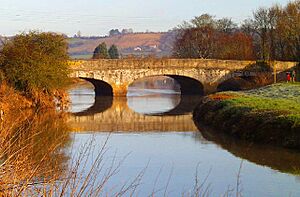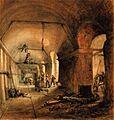William Gravatt facts for kids
Quick facts for kids
William Gravatt
|
|
|---|---|
| Born | 14 July 1806 Gravesend, Kent, England
|
| Died | 30 May 1866 (aged 59) Westminster, London
|
| Occupation | Mechanical and Civil engineer |
| Years active | 1821–1866 |
| Known for | Thames Tunnel, Calder and Hebble Navigation, South Eastern Railway to Dover, Dumpy level, Bristol and Exeter Railway, Craig telescope, Difference engine |
William Gravatt (born July 14, 1806 – died May 30, 1866) was a famous English civil engineer. He also made scientific tools.
He started training as an engineer in London when he was 15. He worked on big projects like the Thames Tunnel. He also designed bridges for canals. While surveying for the South Eastern Railway, he invented the portable dumpy level. This tool is still used everywhere today.
Gravatt also helped build the Bristol and Exeter Railway. He used his special math skills to make construction faster. Later, he helped create the Craig telescope. He also built a copy of the Difference engine, an early computer. He wrote many important papers for engineers.
Contents
Early Life and Learning
William Gravatt was born in Gravesend, England, on July 14, 1806. His father was a military officer. When William was 15, his father arranged for him to train with Bryan Donkin, a mechanical engineer. During this time, he met and became friends with other important scientists and engineers.
Gravatt's Engineering Career
Gravatt joined the Institution of Civil Engineers in 1826. By 1828, he became a full member. He proposed using his "curve of sines" idea for railway curves. In 1832, he became a member of the Royal Society and the Royal Astronomical Society. These are very important science groups.
Working on the Thames Tunnel

Even before finishing his training, Gravatt got a job. He became a supervisor on the Thames Tunnel project. This was a huge project to build a tunnel under the River Thames.
In 1827, the tunnel flooded. Isambard Kingdom Brunel, another famous engineer, told everyone not to go inside. But some directors insisted Gravatt take them to see the damage. While inside, an accident happened, and their boat tipped over. Gravatt and one miner were the only ones who could swim. They saved the directors. Gravatt and Brunel then searched for another missing miner. They were later given silver medals for risking their lives to save others.
Designing Bridges for Canals
In 1832, work on the Thames Tunnel paused because of water problems. Gravatt's mentor, Bryan Donkin, recommended him for a job. He became an engineer for the Calder and Hebble Navigation canal. Gravatt designed special arches for bridges there. He used a strong iron chain above the bridge platform. This design was an early version of the suspension bridge. However, he was replaced early in the project.
Projects with Isambard Kingdom Brunel
Gravatt was asked to survey the route for the South Eastern Railway. This railway would go from London to Dover. During this work, he invented the dumpy level. This is a surveying tool that is much easier to carry around. It is now used all over the world.
In 1834, Brunel hired Gravatt for more projects. His main job was to survey the Taff Vale Railway in Wales. He also designed bridges for the Great Western Railway.
In 1835, Brunel made Gravatt the supervisor for surveying the Bristol and Exeter Railway. Gravatt used his "curve of sines" math idea from the start. This helped make sure the railway lines were built exactly as planned.

Brunel also worked to improve the River Parrett for boats. In 1836, he suggested Gravatt become the engineer for the Westport Canal. Gravatt's Great Bow Bridge, built in 1840 in Langport, is still standing today.
Challenges and New Projects
By 1839, Gravatt's team faced delays on the railway. There were arguments over the best route through soft ground. Costs went up. In 1841, Brunel told shareholders he would dismiss his engineering team. Brunel told Gravatt he had lost trust in him, and Gravatt resigned.
After this, Gravatt designed a drawbridge in Bristol. He also worked on some proposed railway projects. However, he lost a lot of money when many of these projects were never built.
Building the Craig Telescope
Back in London, in 1850, Gravatt was chosen to design and build the Craig telescope. This was a huge refracting telescope (one that uses lenses). It had a lens that was 24 inches wide. Gravatt designed the special stand for it. It was built on Wandsworth Common. The telescope had a 19.5-meter-tall brick tower and a 24.5-meter-long tube.
When it was finished in 1852, the Craig telescope was the largest refracting telescope in the world. However, it had problems with its lens. It was not used much and was taken apart in 1857.
The Difference Engine
In 1854, Per Georg Scheutz brought his Difference engine to London. This was an early type of mechanical computer. Gravatt was very interested. He used his knowledge to have a copy of the machine built.
From 1855, Gravatt gave talks about the machine to important groups, including the Royal Society. He also gave lectures in Paris. He worked to show people how useful the machine was for calculating tables of numbers. For his work in science, he became a member of the Royal Swedish Academy of Sciences.
Contributions to Engineering Discussions
Gravatt was involved in many important discussions at the Institution of Civil Engineers. He talked about topics like jet-propellers and laying underwater telegraph cables. He often wrote papers about his ideas, including his "curve of sines" theorem.
Throughout his career, Gravatt collected many special gifts. These included tools made by famous instrument makers and a piece of Charles Babbage's original difference engine. He left all these items to the Institution of Civil Engineers in his will.
Death
William Gravatt passed away on May 30, 1866, in Westminster, London.
Images for kids
-
Inside the Thames Tunnel during construction, 1830
-
Gravatt's Great Bow Bridge of 1840, spanning the River Parrett, in Langport, Somerset




